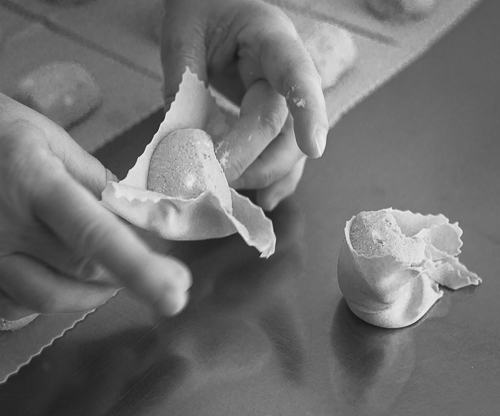In the old town centre of Pula, everyone is advised to visit the Pula confectionery in 147, via Nora in order to enjoy the sight, fragrance and taste of the typical Sardinian sweets prepared by the owner Caterina and her assistant Stefania.
Having entered the shop, it’s possible to let the eyes wander over a large variety of local sweets like spadulas, papassinos, croccantini with apples, almonds and nuts, sebadas and various combinations with dried fruits, honey and so on, while pasta like ravioli with various fillings, noodles, pasta spirals and fregola are placed in another counter.
Although it would have been tempting to buy one of each of the sweets, instead we enter the confectionery adjacent to the shop where all their products are made.
Inside, we are met by Caterina, who in the course of our short visit, seems to be a strong, energetic, determined and capable woman, while also being very sympathetic and hospitable.
While she’s working, she tells us she’s been fond of making sweets since she was only 6-7 years old when she learnt from her mother and grandmother. She loved learning new ways of making all sorts of candies and inventing new ones.
While her sisters bought ice cream when they had received their weekly pocket money, she preferred to buy new ingredients, which she would use to make other sweets. She was never more happy than when she could return home with the required ingredients and doing this creative activity in her spare time.
How she enjoyed herself! She kneaded and manipulated the dough, mixed it with various ingredients in order to make a particular kind of sweet, in the end shaping the dough as she wanted before cooking it in an oven.
Growing up, she studied, got married, started working and got children. In 2000, she was working as an employee, but decided to give her notice in order to invest all her savings and energy into making premises ready for both having a confectionery and an adjacent shop for selling her products. After lots of work and time, Caterina could realise her childhood dream.
15 years later, it’s obvious that she has succeeded and it was the right choice for her, while we feel fortunate to be present watching her daily fulfillment of her dream.
When we enter, she’s inspecting a bucket full of ricotta cheese, holding it in her hands, observing the ricotta closely, sensing the smell and tasting a sample in order to verify if it’s fresh because it easily gets spoiled. While she rejects one bucket of ricotta, she accepts another one and pours the contents into a mixer where it is combined with other ingredients like orange peel, saffron, sugar, flour and eggs in order to form the filling of the sweets.
After having mixed all the ingredients thoroughly, the resulting mousse has to rest at least 12 hours, but Caterina had prepared the required amount of mousse the day before such that she could proceed immediately with making a typical pastry called pardula, which is also called formagella and casadina depending on the region where it’s being made. However, while the mousse is allowed to mature for some more time, she starts preparing the dough, which will contain the filling.
First, she introduces a piece of flat dough into a roller, letting the dough pass back and forth. Being helped by Stefania, the dough gets thinner and longer until it has a thickness of, say, one millimetre, a length of about 4 metres and a width of, say, 40 centimetres. They lift the dough together and put it gently on a workbench. The dough, which consists of flour, water and salt, is also used for making ravioli and sebadas where dough with the smallest thickness is used for making pardulas followed by ravioli and finally sebadas.
Caterina works diligently all the time, dividing the dough longitudinally by using a roller cutter consisting of 4 parallel wheels, an idea which has been conceived by her and made by her husband. Then, she uses another roller cutter to divide the four resulting stripes perpendicularly such that they are divided into equally sized rectangles. Stefania uses a pastry bag to apply the same amount of filling to each rectangle, while Caterina dexterously folds the dough around the filling. Before, we have watched confectioners making stellar shapes of the dough around the filling, but she forms a cylindrical shape for about 180 degrees, while she makes a complex shape of the rest. It seems easy because she works so ably, but only years of experience could allow someone to shape the dough so effortlessly.
Some time later, small fragrant miracles emerge from the oven. The dough has become golden and crisp, while the filling looks delicious, pleasant aromas fill the workshop and our noses and the taste? Caterina invites us to have a taste, a delicious taste indeed, resulting from the hands of a skilled artisan.

